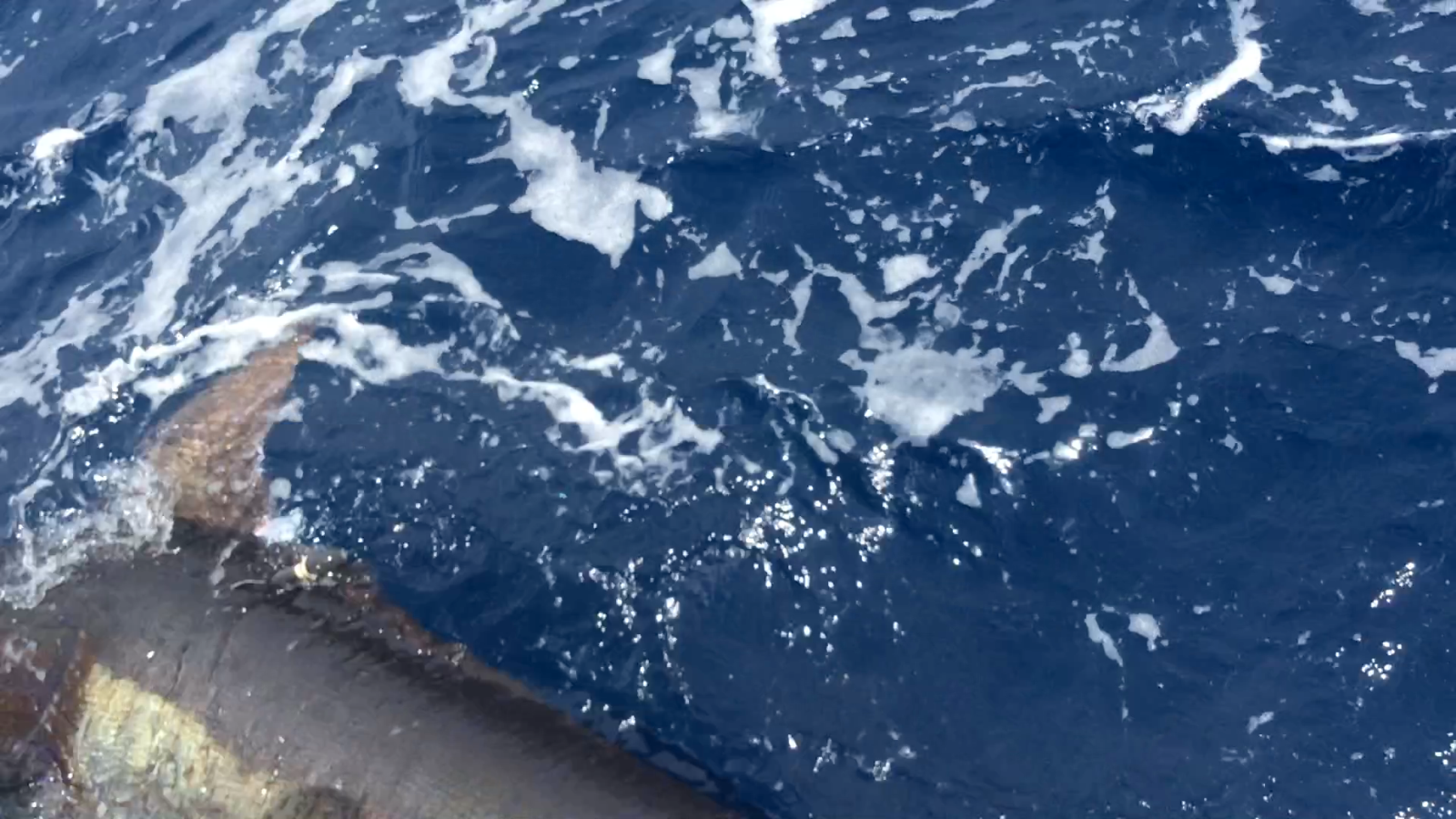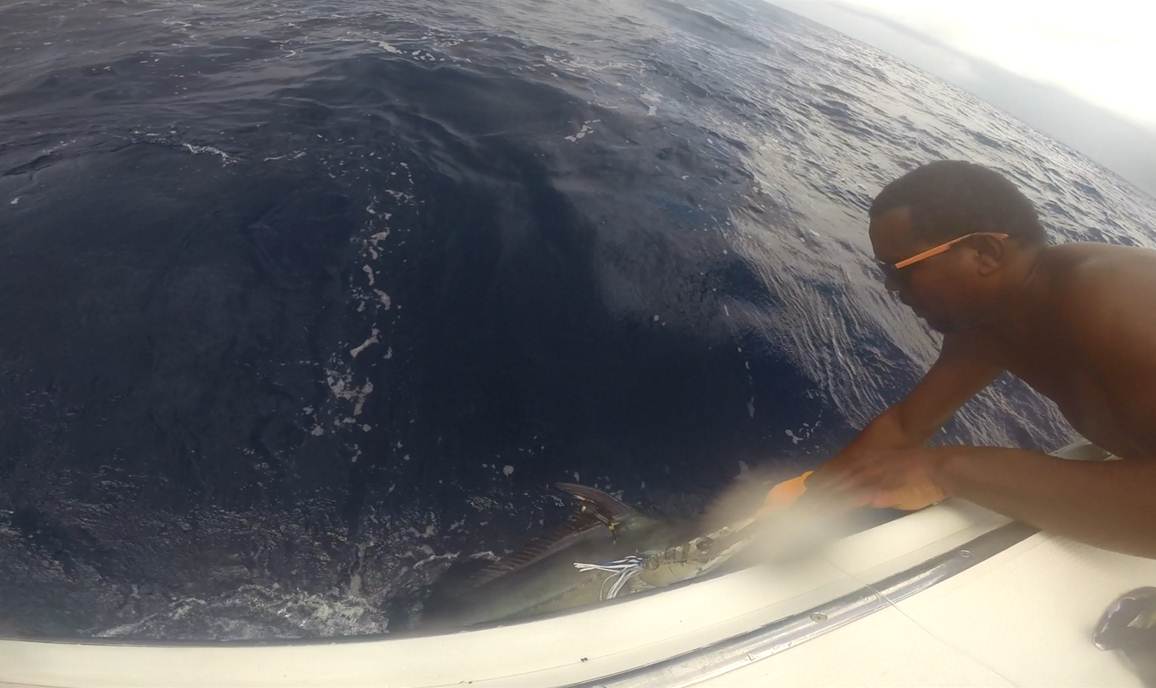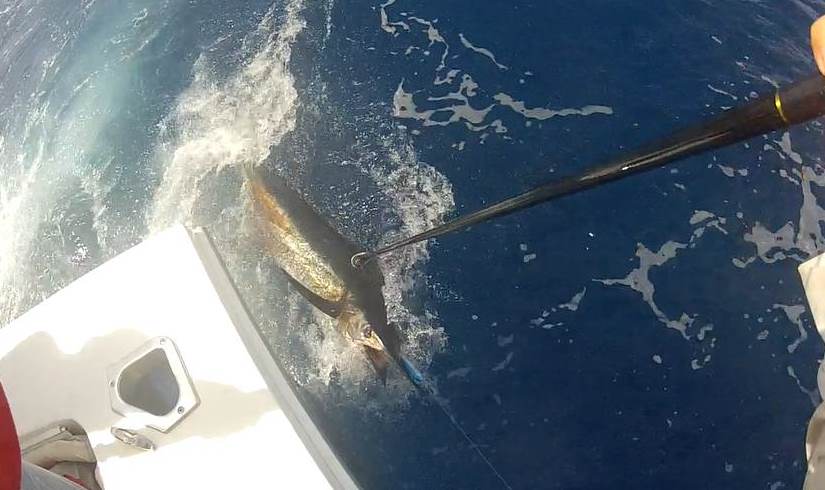.jpg)
SSFC Big Game Classic convoy headed out to sea
Photo taken by Annalise Savy

Estimated 240 kg black marlin released with Team 1 Island Star's satellite tag

Team 2 Blue Lady's blue marlin revived boatside after being tagged

Henry Riggs-Miller of Team Albemarlin places third satellte tag in blue marlin
|
Victoria, Seychelles 2014 Race Update
MAY 2015 -- We have are nearing the end of the 2014 Victoria, Seychelles IGFA Great Marlin Race (IGMR) where two blue and one black marlin are competing for first place!
As reported in the last update, the third tag in the race popped off of Team Albemarlin’s 45 kg (99 lb) blue marlin after six days. After close examination of the data, we concluded that the tag was most likely consumed by a yellowfin tuna!
When Team Albemarlin’s blue was first released, it exhibited typical marlin diving behavior with the expected associated temperatures (ie colder temperatures as the marlin swam deeper in water column). However, several hours later, the diving behavior recorded by the tag changed, and the temperature remained relatively consistent with changes in depth. Also, the tag stopped detecting light which reaffirmed that the tag was definitely inside something’s stomach. The tag stayed inside the stomach of the animal for several days before it was egested, floated to the surface, and began transmitting the data to Argos.
In the IGMR, we have experienced data like this before, and have concluded that these occurrences were likely predation events (which we have often attributed to lamnid sharks such as mako or white sharks). However, in those circumstances, the temperatures that the tag recorded were much more consistent and indicative of being inside of an endothermic (warm-bodied) lamnid shark, where in this instance, the recorded temperatures varied by several degrees which is more similar to the internal temperature of an ectothermic (cold blooded) species.
While it is possible that this event reflects consumption of the marlin by an ectothermic species of shark, there is an althernative hypothesis. A local Seychelles expert, who reviewed the data, suggested that this was unlikely a shark predation event since sharks often stay at deep depths for long periods of time and the tag data showed that this depth change occurrence was a quick dive (within a 30 minute period). The expert also stated he had witnessed similar diving behavior from Yellowfin tuna that, in order to remove parasites from themselves, will make dives to 1,200 meters (m) for around 20 minutes and then return to shallower depths. Indeed, the animal with the tag inside its stomach undertook such a dive to an incredible depth of almost 1,100 m, a depth that is much deeper than the maximum depths recorded for any malrin tagged during any IGMR event.
Since recent scientific publications revealed that Yellowfin tuna exhibit similar diving behaviors as the behavior recorded by this tag, and the evidence of scrape marks and teeth marks on recovered satellite tags reveal that it is possible that other animals may be attracted to the tags and bite them, we believe the possibility exists that this tag was ingested by a Yellowfin Tuna. It is possible that the tuna bit the tag off of the marlin or perhaps a shark preyed upon the marlin and the yellowfin ingested the scraps which contained the tag. We’d like to thank the World Wildlife Fund for Nature (WWF) for sponsoring this tag. Although we know it is disappointing to not see a track of their marlin, their support has allowed for this amazing discovery – something we’ve never witness before in the IGFA Great Marlin Race!
As for the other two marlin in the race, Tag 2 that was sponsored by Oceana Fisheries and placed on Team Blue Lady’s blue marlin popped up on January 25, 2015. After 57 days on the marlin, the tag revealed that the estimated 70 kg (154 lb) fish swam a point to point distance of 600 nm and a total estimated distance of 709 nm! The track is available on the race page.
Tag 1 that was sponsored by Bisbee’s Fish and Wildlife Conservation Fund is still recording data on Team Island Star’s 240 kg (529) black marlin and is due to surface at the end of the month.
Victoria, Seychelles 2014 Race Start
JANUARY 2015 -- It’s been one month since the 2014 Victoria, Seychelles IGFA Great Marlin Race (IGMR) where three tags went out on two blue and one black marlin during the single day tournament, SSFC Big Game Classic.
Famous for its granite and coral islands and stunning beaches, Seychelles is also known for its fantastic marlin fishing. On Saturday, November 29 2014, The Seychelles Sports Fishing Club (SSFC) and Bisbee’s Fish & Wildlife Conservation Fund teamed up to host a first ever IGMR in beautiful Seychelles which became the 15th country in the world be added to the IGFA Great Marlin Race!
At 11:15 am on November 29, 2014, SSFC secretary Grant Heyer received a call from Marc Houareau, one of the anglers fishing aboard Island Star, that they had just successfully deployed their satellite tag on a “beauty of a black marlin estimated at around 240 kg (529 lbs)”. Marc’s uncle, Davis Houareau, fought the fish for 20 minutes before Anthony Payet deployed the first tag of the race on the fish. This tag was the first of five tags generously sponsored by Bisbee’s Fish & Wildlife Conservation Fund to be deployed in Seychelles. Right afterwards, Capt. Danny Lowlam of Blue Lady reported that tagger Ronny placed their tag on an estimated 70 kg ( 154 lb) blue marlin after a 20 minute fight with angler Mervyn. The second tag of the event was the first of two satellite tags graciously sponsored by Oceana Fisheries.
A few hours later, the third tag of the race was deployed on an estimated 45 kg (99 lb) marlin by Henry Riggs-Miller after a quick fight with angler Daniel Hoenings aboard Albemarlin. Unfortunately, this tag popped off the fish six days later, 152 nautical miles away from where it is tagged. The premature release of the tag could be related to a fishing boat capture as the pop-up location is a heavily commercially fished zone, but we are looking into this further and any insight we have will be reported shortly. The tag was the first of two satellite tags sponsored by World Wide Fund for Nature (WWF) in an effort to promote conservation of the Seychelles marine environment.
Although there were nine other tags sponsored for deployment in this race, rough and rainy weather prevented that from happening. Therefore, the remaining nine tags sponsored by Bisbee Fish & Wildlife Conservation Fund, A1 Sportfishing, WWF, Oceana Fisheries, Eden Island, and Seychelles Fishing Authority will be placed on boats for deployment at the end of the month during the Marlin Slam 2015. This single day tournament will take place on January 31, 2015 at Eden Island where we hope that all nine tags will join the 2015 Victoria, Seychelles IGMR. For now, stay tuned to the race page for updates on who will be declared the 2014 Victoria, Seychelles IGMR champ!
There is still time to get involved! If you’re interested in sponsoring a tag for the 2015 Victoria, Seychelles IGMR, please email Grant Heyer and if you or someone you know may be interested in receiving IGMR Seychelles updates, please email Leah Baumwell.
|